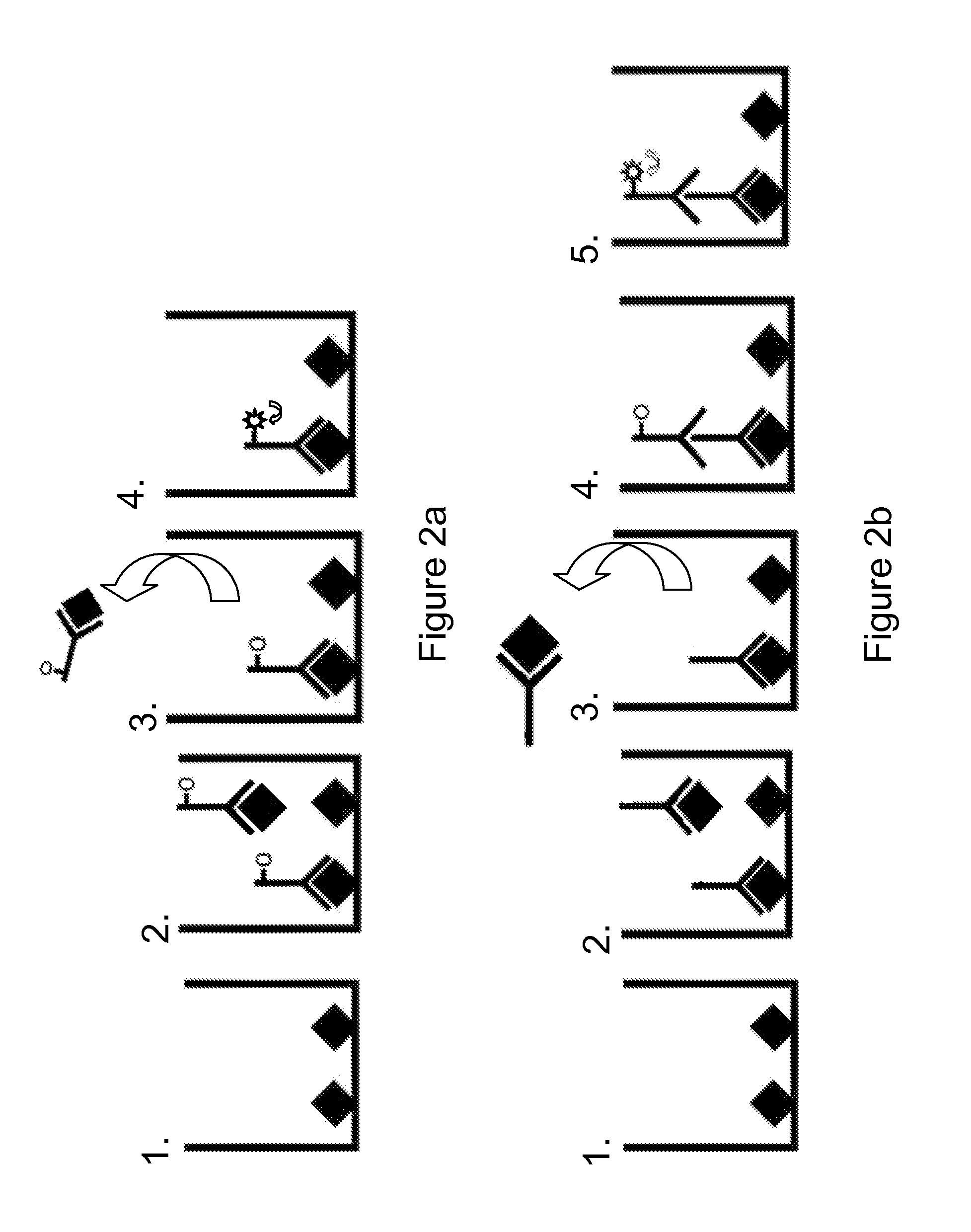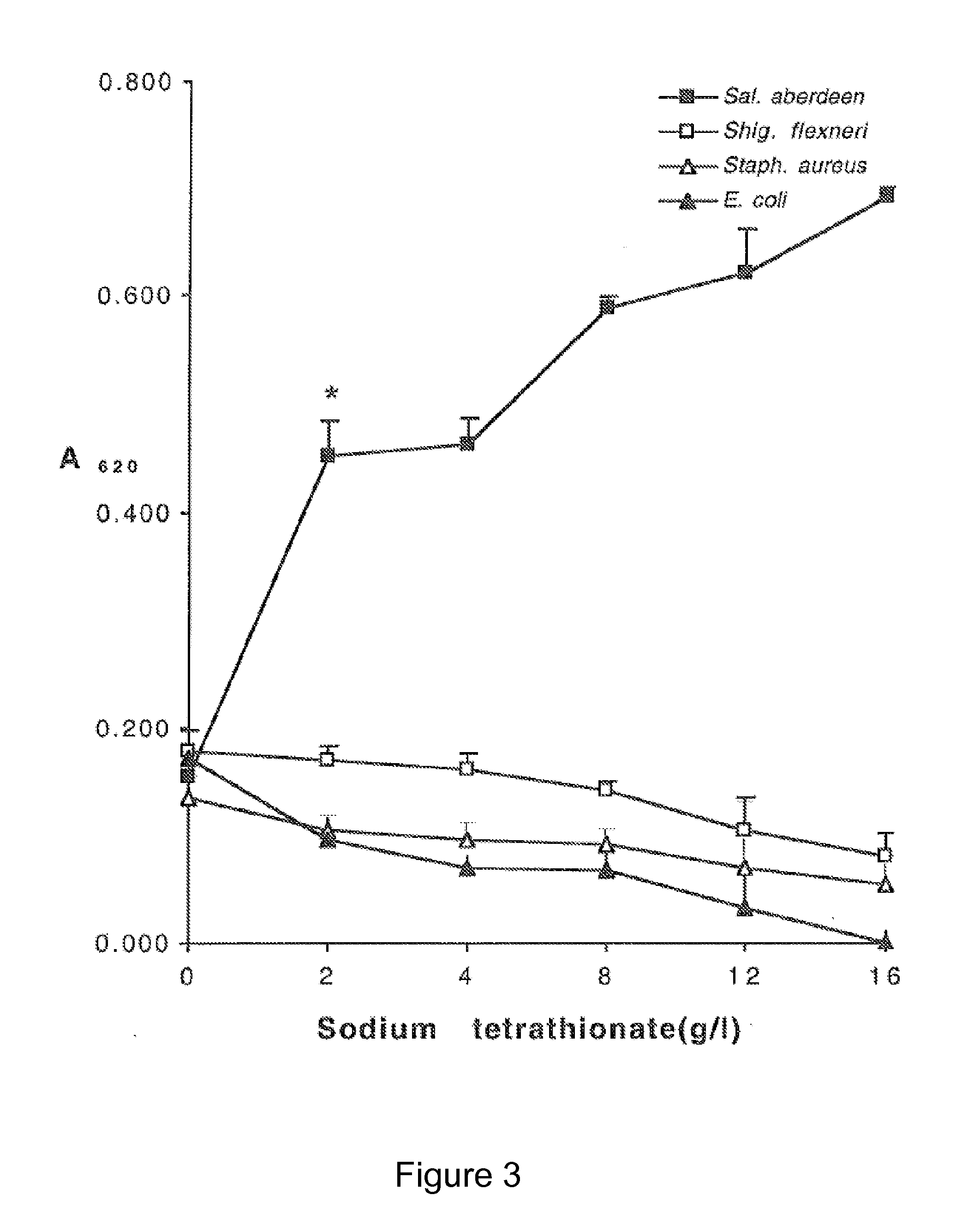Compositions and methods for the rapid growth and detection of microorganisms
a technology of microorganisms and compositions, applied in the field of compositions and methods for the rapid growth and detection of microorganisms, can solve the problems of inefficient and slow, waste delay, and significant cost arising from such delays, and achieve the effects of rapid recovery and growth of salmonella, efficient and rapid growth of salmonella, and preventing the recovery of sick
- Summary
- Abstract
- Description
- Claims
- Application Information
AI Technical Summary
Benefits of technology
Problems solved by technology
Method used
Image
Examples
example 1
Preparation of Culture Media for Growth of Salmonella
[0131]FIG. 3 demonstrates the effect of sodium tetrathionate at concentrations of between 0 and 16 g / L on the growth of Salmonella aberdeen, Shigella flexneri, Staphylococcus aureus and E. coli. 0.1 ml inoculum (103 cells / ml) was added to a 100 ml conical flask containing tryptic soy broth with 0 to 16 g / L of sodium tetrathionate. The flask was incubated at 37° C. for 18 hours. After this time, the A620 was measured. Each value represents the mean±SD of three separate experiments. * shows pShigella, Staphylococcus and E. coli are inhibited in contrast to growth of Salmonella which is un-affected or promoted.
Concentration(g / litre)E. coliA620SalmonellaA620 00.2140.2080.1560.138 40.0960.1040.1870.179 8*0.0780.0730.8180.848120.0530.0480.2260.270150.0110.0110.1670.186200.0150.0180.1500.139250.0230.0220.0860.099300.0210.0200.0590.073
[0132]Not only does the Tetrathionate inhibit the growth of E. coli at levels of >4 g / litre but at a con...
example 2
Preparation of Culture Media for Growth of Shigella
[0135]FIG. 5 demonstrates the growth response of bacteria to ammonium ferric citrate. 0.1 ml inoculum (103 cells / ml) was added to a 100 ml conical flask containing tryptic soy broth with 0.25 to 1.5 g / L of ammonium ferric citrate. The flask was incubated at 37° C. for 18 hours. After this time, the A620 was measured. Each value represents the mean±SD of three separate experiments. * shows pStaphylococcus and E. coli are limited.
[0136]FIG. 6 demonstrates the growth response of bacteria to sodium citrate. 0.1 ml inoculum (103 cells / ml) was added to a 100 ml conical flask containing tryptic soy broth with 5 to 25 g / L of sodium citrate. The flask was incubated at 37° C. for 18 hours. After this time, the A620 was measured. Each value represents the mean±SD of three separate experiments. * shows pStaphylococcus and E. coli are limited. At levels of 15 g / L the growth response of Shigella is significantly increased over those of Staphyloc...
example 3
Generation Study of Different Bacteria in Peptone, Tryptic Soy Broth and Modified Tryptic Soy Broth
[0137]Three strains of Shigella and other bacteria including Salmonella aberdeen, E. coli and Staphylococcus aureus were grown in conventional broth cultures to investigate the generation time. 0.1 ml inoculum (103 cells / ml) was added to a 100 ml conical flask containing either peptone (FIG. 7), trypric soy broth (TSB) (FIG. 8), modified tryptic soy broth (mTSB) (FIG. 9) or gram-negative broth (FIG. 10).
[0138]Each flask was incubated at 37° C. for 18 hours. After this time, the number of viable cells was determined by drop plate technique on nutrient agar. The values in parenthesis are generation times. Each value represents the mean±SD of three separate experiments. * shows pShigella flexneri, Salmonella aberdeen, E. coli and Staphylococcus aureus was 36, 57, 41 and 44 min respectively when they were grown in Gram-negative broth.
[0139]The growth rate of all bacteria increased in TSB. ...
PUM
| Property | Measurement | Unit |
|---|---|---|
| concentration | aaaaa | aaaaa |
| temperatures | aaaaa | aaaaa |
| temperatures | aaaaa | aaaaa |
Abstract
Description
Claims
Application Information
 Login to View More
Login to View More - R&D
- Intellectual Property
- Life Sciences
- Materials
- Tech Scout
- Unparalleled Data Quality
- Higher Quality Content
- 60% Fewer Hallucinations
Browse by: Latest US Patents, China's latest patents, Technical Efficacy Thesaurus, Application Domain, Technology Topic, Popular Technical Reports.
© 2025 PatSnap. All rights reserved.Legal|Privacy policy|Modern Slavery Act Transparency Statement|Sitemap|About US| Contact US: help@patsnap.com



